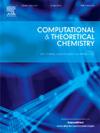利用外电场和施加双轴应变制备电子性能可调的直接Z-scheme HfSSe/BSe vdW异质结构光催化剂
IF 3
3区 化学
Q3 CHEMISTRY, PHYSICAL
引用次数: 0
摘要
本文利用外加电场和施加双轴应变对HfSSe/BSe范德华(vdW)异质结构的结构和电子性能进行了调制。HfSSe/BSe vdW异质结构在SSe接触处的h1堆积是热力学、热力学和动力学稳定的。组成单层HfSSe和BSe的直接带隙(0.70 eV)比间接带隙(0.96 eV和2.62 eV)更小,表现出HfSSe/BSe vdW异质结构对太阳光的吸收范围更广。直接的Z-scheme机制使得HfSSe/BSe vdW异质结构具有光生载流子的高效空间分离和强氧化还原能力。此外,外加电场(−0.50 ~ 0.50 V/Å)可以有效地调制HfSSe/BSe vdW异质结构的带向、带隙,并诱导其在- 0.40、- 0.20、0.00、0.13 V/Å的拐点处由金属→半导体(ii型→i型→ii型)→金属的带型跃迁。而施加的双轴应变(- 5.0 ~ 5.0%)也可以调节带隙,并导致HfSSe/BSe vdW异质结构在- 4.0和1%的拐点分别从金属→半导体(直接→间接)发生带型转变。这些发现为HfSSe/BSe vdW异质结构在纳米电子和光电子器件中的潜在应用提供了理论指导。本文章由计算机程序翻译,如有差异,请以英文原文为准。

A direct Z-scheme HfSSe/BSe vdW heterostructure photocatalyst with tunable electronic properties through external electric field and applied biaxial strain
In this paper, the structural and electronic properties of the HfSSe/BSe van der Waals (vdW) heterostructure have been modulated by using external electric field and applied biaxial strain. The H1-stacking in S![]() Se contact of the HfSSe/BSe vdW heterostructure is thermodynamic, thermal and dynamical stable. The smaller direct band gap of 0.70 eV than the indirect band gaps of 0.96 and 2.62 eV for the constituent monolayers HfSSe and BSe respectively exhibits the HfSSe/BSe vdW heterostructure a broader range of solar light absorption. The direct Z-scheme mechanism makes the HfSSe/BSe vdW heterostructure an efficient spatial separation of the photogenerated carriers and a strong redox ability. Furthermore, the external electric fields (−0.50 to 0.50 V/Å) can effectively modulate the band alignments, the band gaps and induce band type transitions of the HfSSe/BSe vdW heterostructure from metal → semiconductor (type-II → type-I → type-II) → metal at the turning points of −0.40, −0.20, 0.00, 0.13 V/Å, respectively. While the applied biaxial strains (−5.0 to 5.0 %) can also adjust the band gaps and cause the band type transitions of the HfSSe/BSe vdW heterostructure from metal → semiconductor (direct→ indirect) at the turning points of −4.0 and 1 %, respectively. These findings provide the theoretical guide for the potential application of the HfSSe/BSe vdW heterostructure in nano-electronic and optoelectronic devices.
Se contact of the HfSSe/BSe vdW heterostructure is thermodynamic, thermal and dynamical stable. The smaller direct band gap of 0.70 eV than the indirect band gaps of 0.96 and 2.62 eV for the constituent monolayers HfSSe and BSe respectively exhibits the HfSSe/BSe vdW heterostructure a broader range of solar light absorption. The direct Z-scheme mechanism makes the HfSSe/BSe vdW heterostructure an efficient spatial separation of the photogenerated carriers and a strong redox ability. Furthermore, the external electric fields (−0.50 to 0.50 V/Å) can effectively modulate the band alignments, the band gaps and induce band type transitions of the HfSSe/BSe vdW heterostructure from metal → semiconductor (type-II → type-I → type-II) → metal at the turning points of −0.40, −0.20, 0.00, 0.13 V/Å, respectively. While the applied biaxial strains (−5.0 to 5.0 %) can also adjust the band gaps and cause the band type transitions of the HfSSe/BSe vdW heterostructure from metal → semiconductor (direct→ indirect) at the turning points of −4.0 and 1 %, respectively. These findings provide the theoretical guide for the potential application of the HfSSe/BSe vdW heterostructure in nano-electronic and optoelectronic devices.
求助全文
通过发布文献求助,成功后即可免费获取论文全文。
去求助
来源期刊

Computational and Theoretical Chemistry
CHEMISTRY, PHYSICAL-
CiteScore
4.20
自引率
10.70%
发文量
331
审稿时长
31 days
期刊介绍:
Computational and Theoretical Chemistry publishes high quality, original reports of significance in computational and theoretical chemistry including those that deal with problems of structure, properties, energetics, weak interactions, reaction mechanisms, catalysis, and reaction rates involving atoms, molecules, clusters, surfaces, and bulk matter.
 求助内容:
求助内容: 应助结果提醒方式:
应助结果提醒方式:


